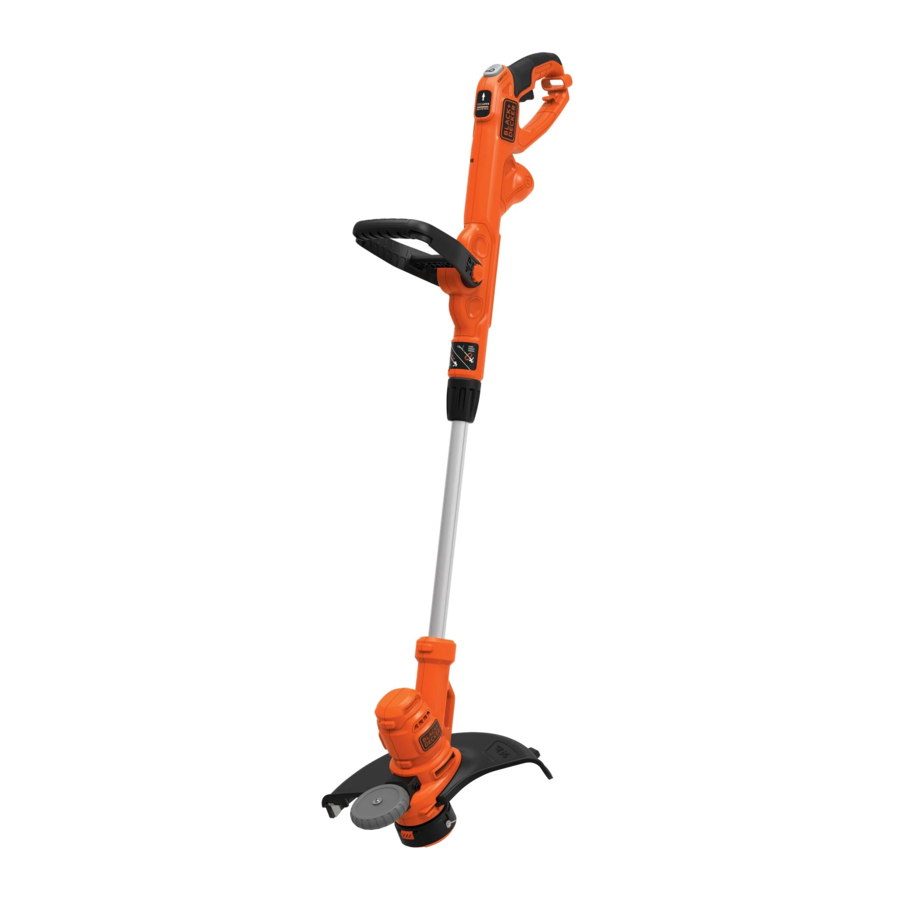
Black & Decker GH900 - String Trimmer Manual
- Instruction manual (41 pages) ,
- Instruction manual (33 pages) ,
- Instruction manual (11 pages)
Advertisement

Definitions: Safety Alert Symbols and Words
This instruction manual uses the following safety alert symbols and words to alert you to hazardous situations and your risk of personal injury or property damage.
Indicates an imminently hazardous situation which, if not avoided, will result in death or serious injury.
Indicates a potentially hazardous situation which, if not avoided, could result in death or serious injury.
Indicates a potentially hazardous situation which, if not avoided, may result in minor or moderate injury.

NOTICE: Indicates a practice not related to personal injury which, if not avoided, may result in property damage.
Intended Use
This string trimmer is designed for household trimming and edging applications. The GH900 contains an automatic line feeding system which does not require the user to bump the trimmer to advance the line.
DO NOT use under wet conditions or in presence of flammable liquids or gases.
DO NOT let children come into contact with the tool.
Supervision is required when inexperienced operators use this tool.
DO wear appropriate safety glasses, closed toe shoes and long pants.
Important Safety Warnings
When using electric gardening appliances, basic safety precautions should always be followed to reduce risk of fire, electric shock, and personal injury, including the following.
Do not remove guard.
The guard must be attached during use. Operating this trimmer without the guard will violate the product warranty.
When replacing the line, use only 0.065" (1.65 mm) diameter round line. Other diameters or shapes may degrade performance or cause damage to the trimmer. Do not use wire.
READ ALL INSTRUCTIONS
- ALWAYS WEAR EYE PROTECTION – Wear safety glasses or goggles at all times when plugged in. These items are available for purchase.
- GUARD ‑ Do not use this appliance without the guard attached.
- DRESS PROPERLY – Do not wear loose clothing or jewelry. They can be caught in moving parts. Gloves and closed-toe, substantial rubber-soled footwear are recommended when working outdoors. Don't operate the appliance when barefoot or wearing open sandals. Wear heavy long pants to protect your legs. Wear protective hair covering to contain long hair.
- NYLON LINE – Keep face, hands and feet clear of rotating nylon line at all times.
- THE ROTATING LINE PERFORMS A CUTTING FUNCTION – Use care when trimming around screens and desirable plantings.
- DO NOT USE materials not recommended, such as metal wire, rope, and the like.
- KEEP ALL BYSTANDERS AWAY – at a safe distance from work area, especially children.
- KEEP CHILDREN, BYSTANDERS AND ANIMALS AWAY from the work area a minimum of 100 feet (30 meters) when starting or operating the unit.
- TO REDUCE THE RISK of rebound (ricochet) injury, work going away from any nearby solid object such as wall, steps, large stone, tree, etc. Use great care when working close to solid objects and where necessary, do trimming by hand.
- AVOID ACCIDENTALLY STARTING – Don't carry trimmer with finger on trigger.
- USE THE RIGHT appliance – Do not use this appliance for any job except that for which it is intended.
- DON'T OVERREACH – Keep proper footing and balance at all times.
- DON'T FORCE APPLIANCE – It will do the job better and with less likelihood of a risk of injury at the rate for which it was designed.
- DAMAGE TO UNIT – If you strike or become entangled with a foreign object, stop appliance immediately, unplug, check for damage and have any damage repaired before further operation is attempted. Do not operate with a broken hub or spool.
- DAMAGE TO CORD – Keep power cord away from rotating line. If you damage the cord, unplug it from the power supply before moving the tool or examining the damage. A damaged cord must be replaced before further use.
- SECURE EXTENSION CORD using the cord retainer shown in in this manual.
- DISCONNECT TRIMMER – when not in use, when replacing line, or prior to cleaning.
- AVOID DANGEROUS ENVIRONMENTAL CONDITIONS – Do not use electric appliances in damp or wet locations. Follow all instructions in this instruction manual for proper operation of your appliance. Don't use the appliance in the rain.
- DO NOT OPERATE portable electric appliances in gaseous or explosive atmospheres. Motors in these appliances normally spark, and the sparks might ignite fumes.
- STORE IDLE APPLIANCES INDOORS – When not in use, appliances should be stored indoors in a dry, locked‑up place out of reach of children.
- STAY ALERT – Do not operate this unit when you are tired, ill, or under the influence of alcohol, drugs, or medication.
- MAINTAIN APPLIANCES WITH CARE – Follow instructions in Maintenance section. Keep handles dry, clean and free from oil and grease.
- GROUND FAULT CIRCUIT INTERRUPTER (GFCI) protection should be provided on the circuit(s) or outlet(s) to be used for the trimmer. Receptacles are available having built‑in GFCI protection and may be used for this measure of safety.
- CHECK DAMAGED PARTS – Before further use of the appliance, a guard or other part that is damaged should be carefully checked to determine that it will operate properly and perform its intended function. Check for alignment of moving parts, binding of moving parts, breakage of parts, mounting, and any other condition that may affect its operation. A guard or other part that is damaged should be properly repaired or replaced by an authorized service center unless otherwise indicated elsewhere in this manual.
- DO NOT immerse appliance in water or squirt it with a hose. DO NOT allow any liquid to get inside it.
- DO NOT store the appliance on or adjacent to fertilizers or chemicals.
- DO NOT clean with a pressure washer.
- KEEP GUARDS in place and in working order.
- KEEP HANDS AND FEET away from cutting area.
- INSPECT THE AREA before using the unit. Remove all debris and hard objects such as rocks, glass, wire, etc. that can ricochet, be thrown, or otherwise cause injury or damage during operation.
- WHEN BEING USED AS AN EDGER – stones, pieces of metal, pieces of cutting line/resin blade and other objects can be thrown out at high speed durning use. The appliance and guard are designed to reduce the hazard. To reduce the risk of rebound (ricochet) injury, work going away from any nearby solid object such as wall, steps, large stone, tree, etc.
- DO NOT allow any liquid to get inside it. If appliance does get wet, allow to dry for a minimum of 48 hours.
- DO NOT leave appliance when plugged in. Unplug from outlet when not in use and before servicing.
- DO NOT use with damaged cord or plug. If appliance is not working as it should, has been dropped, damaged, left outdoors, or dropped into water, return it to a service center.
- DO NOT pull or carry by cord, use cord as a handle, or pull cord around sharp edges or corners. Keep cord away from heated surfaces.
- DO NOT unplug by pulling on cord. To unplug, grasp the plug, not the cord.
- DO NOT handle plug or appliance with wet hands.
- TURN OFF all controls before unplugging.
- This appliance is provided with double insulation. Use only identical replacement parts. See instructions for Servicing of Double Insulated Appliances.
- To reduce the risk of electric shock, use only with an extension cord intended for outdoor use, such as SJW or SJTW.
- Make sure your extension cord is in good condition and is the correct size for your appliance. The Minimum Gauge for Cord Sets chart shows the correct size to use depending on cord length and nameplate ampere rating. If in doubt, use the next heavier gauge. The smaller the gauge number, the heavier the cord. An undersized extension cord will cause a drop in line voltage resulting in loss of power and overheating.
- Maintain Appliance With Care – Inspect extension cords periodically and replace if damaged.
- To reduce the risk of disconnection of appliance cord from the extension cord during operating:
- Make a knot as shown in Fig. T; OR
- Use one of the plug‑receptacle retaining straps or connectors described in this manual; OR
- Secure the extension cord to the appliance plug as shown or described in the Operating Instructions.
To reduce the risk of personal injury due to a loose electrical connection between the appliance's plug and extension cord, firmly and fully attach the appliance plug to the extension cord. Periodically check the connection while operating to ensure it is fully attached. Do not use an extension cord that provides a loose connection. A loose connection may result in overheating, fire, and increases the risk of a burning.
Do not use appliance if the trigger switch does not turn the appliance on or off. Any appliance that cannot be controlled with the trigger switch is dangerous and must be repaired.
Additional Safety Information
Never modify the power tool or any part of it. Damage or personal injury could result.
ALWAYS use safety glasses. Everyday eyeglasses are NOT safety glasses. Also use face or dust mask if operation is dusty. ALWAYS WEAR CERTIFIED SAFETY EQUIPMENT:
- ANSI Z87.1 eye protection (CAN/CSA Z94.3),
- ANSI S12.6 (S3.19) hearing protection,
- NIOSH/OSHA/MSHA respiratory protection.
Some dust contains chemicals known to State of California to cause cancer, birth defects or other reproductive harm. Some examples of these chemicals are:
- compounds in fertilizers,
- compounds in insecticides, herbicides and pesticides,
- arsenic and chromium from chemically treated lumber.
To reduce your exposure to these chemicals, wear approved safety equipment such as dust masks that are specially designed to filter out microscopic particles.
- Avoid prolonged contact with dust from power sanding, sawing, grinding, drilling, and other construction activities. Wear protective clothing and wash exposed areas with soap and water. Allowing dust to get into your mouth, eyes, or lie on the skin may promote absorption of harmful chemicals.
Use of this tool can generate and/or disperse dust, which may cause serious and permanent respiratory or other injury. Always use NIOSH/OSHA approved respiratory protection.
Always wear proper personal hearing protection that conforms to ANSI S12.6 (S3.19) during use. Under some conditions and duration of use, noise from this product may contribute to hearing loss.
When not in use, place tool on its side on a stable surface where it will not cause a tripping or falling hazard. Some tools will stand upright but may be easily knocked over.
- Air vents often cover moving parts and should be avoided. Loose clothes, jewelry or long hair can be caught in moving parts.
- An extension cord must have adequate wire size (AWG or American Wire Gauge) for safety. The smaller the gauge number of the wire, the greater the capacity of the cable, that is, 16 gauge has more capacity than 18 gauge. An undersized cord will cause a drop in line voltage resulting in loss of power and overheating. When using more than one extension to make up the total length, be sure each individual extension contains at least the minimum wire size. The following table shows the correct size to use depending on cord length and nameplate ampere rating. If in doubt, use the next heavier gauge. The lower the gauge number, the heavier the cord.
Minimum Gauge for Cord Sets
| Volts | Total Length of Cord in Feet (meters) | ||||
| 120 V | 25 (7.6) | 50 (15.2) | 100 (30.5) | 150 (45.7) | |
| 240 V | 50 (15.2) | 100 (30.5) | 200 (61.0) | 300 (91.4) | |
| Ampere Rating | American Wire gauge | ||||
| More Than | Not More Than | ||||
| 0 | 6 | 18 | 16 | 16 | 14 |
| 6 | 10 | 18 | 16 | 14 | 12 |
| 10 | 12 | 16 | 16 | 14 | 12 |
| 12 | 16 | 14 | 12 | Not Recommended | |
Safety Rules and Instructions: Extension Cords
To reduce the risk of electric shock, use only with an extension cord intended for outdoor use, such as an extension cord of cord type SW‑A, SOW‑A, STW‑A, STOW‑A, SJW‑A, SJOW‑A, SJTW‑A. or SJTOW‑A.
Make sure your extension cord is in good condition. When using an extension cord, be sure to use one heavy enough to carry the current your product will draw. An undersized cord will cause a drop in line voltage resulting in loss of power and overheating. The table shows the correct size to use depending on cord length and nameplate ampere rating. If in doubt, use the next heavier gauge. The smaller the gauge number, the heavier the cord. If the extension will be used outside, the cord must be suitable for outdoor work. The letters "WA" on the cord jacket indicate that the cord is suitable for outdoor use.
Servicing of Double Insulated Appliances
Your appliance is double‑insulated to give you added safety. In a double insulated appliance, two systems of insulation are provided instead of grounding. No grounding means is provided on a double insulated appliance, nor should a means for grounding be added to the appliance. Servicing a double insulated appliance requires extreme care and knowledge of the system and should be done only by qualified service personnel. Replacement parts for a double insulated appliance must be identical to the parts they replace. A double insulated appliance is marked with the words double insulated or "double insulation". The symbol (square within a square) may also be marked on the appliance.
Safety Rules and Instructions: Extension Cords
Double insulated appliances have 2‑wire cords and can be used with 2‑wire or 3‑wire extension cords. Only round jacketed extension cords should be used, and we recommend that they be listed by Underwriters Laboratories (U.L.) (C.S.A. in Canada). If the extension will be used outside, the cord must be suitable for outdoor use. Any cord marked as outdoor can also be used for indoor work.
Before using an extension cord, inspect it for loose or exposed wires, damaged insulation, and defective fittings. Make any needed repairs or replace the cord if necessary.
Safety Rules and Instructions: Polarized Plug
To reduce the risk of electric shock, this appliance has a polarized plug (one blade is wider than the other). This equipment must be used with a suitable polarized 2 wire or 3 wire extension cord. Polarized connections will fit together only one way. Make sure that the receptacle end of the extension cord has large and small blade slot widths. If the plug does not fit fully into the extension cord, reverse the plug. If it still does not fit, obtain a suitable extension cord. If the extension cord does not fit fully into the outlet, contact a qualified electrician to install the proper outlet. Do not change the appliance plug or extension cord in any way.
Motor
Be sure your power supply agrees with the nameplate marking. Voltage decrease of more than 10% will cause loss of power and overheating. These tools are factory tested; if this tool does not operate, check power supply.
The label on your tool may include the following symbols. The symbols and their definitions are as follows:
| V | volts |
| Hz | hertz |
| min | minutes |
 or DC or DC | direct current |
 | Class I Construction (grounded) |
| .../min | per minute |
| BPM | beats per minute |
| IPM | impacts per minute |
| OPM | oscillations per minute |
| RPM | revolutions per minute |
| sfpm | surface feet per minute |
| SPM | strokes per minute |
| A | amperes |
| W | watts |
| Wh | watt hours |
| Ah | amp hours |
 or AC or AC | alternating current |
 or AC/DC or AC/DC | alternating or direct current |
 | Class II Construction (double insulated) |
| no | no load speed |
| n | rated speed |
| PSI | pounds per square inch |
 | earthing terminal |
 | safety alert symbol |
 | visible radiation – do not stare into the light |
 | wear respiratory protection |
 | wear eye protection |
 | wear hearing protection |
 | read all documentation |
 | do not expose to rain |
ASSEMBLY AND ADJUSTMENTS
To reduce the risk of serious personal injury, turn unit off and disconnect it from power source before making any adjustments or removing/installing attachments or accessories, when replacing line, or prior to cleaning. An accidental start‑up can cause injury.
Overview
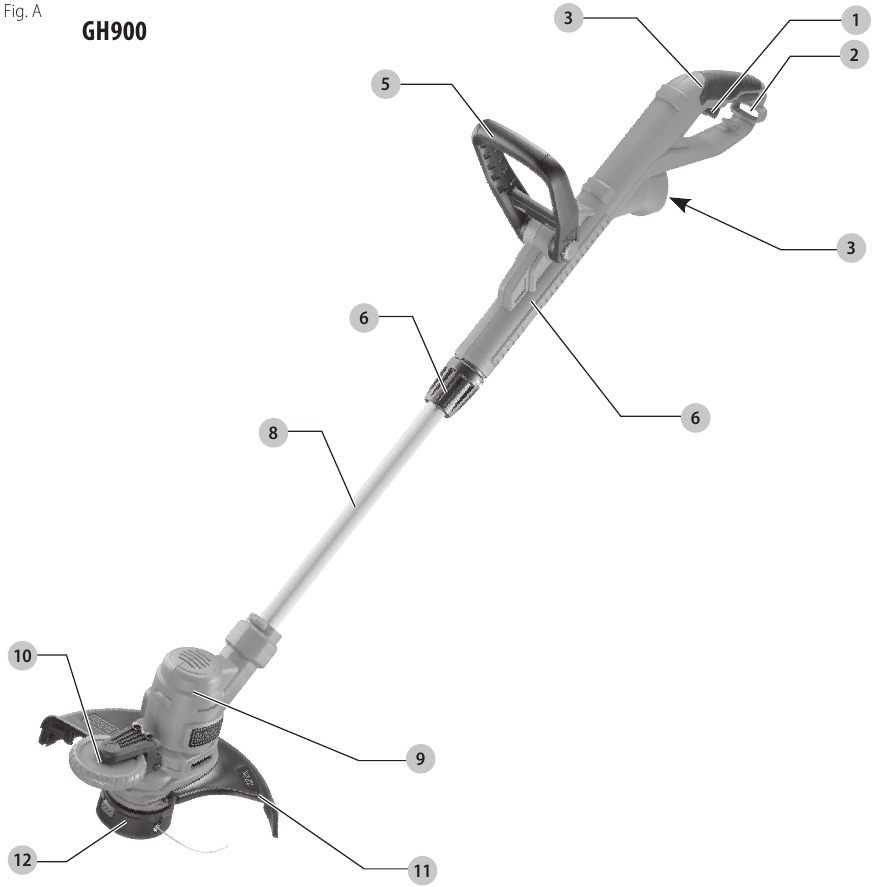
- On/Off trigger switch
- Cord retainer
- Power cord plug
- Main handle
- Auxiliary handle
- Main housing
- Collar
- Lower pole
- Motor housing
- Edge guide wheel
- Guard
- Spool housing
Attaching the Auxiliary Handle
For some models the auxiliary handle  may need to be attached. If the model needs the auxiliary handle attached, please refer to these instructions.
may need to be attached. If the model needs the auxiliary handle attached, please refer to these instructions.
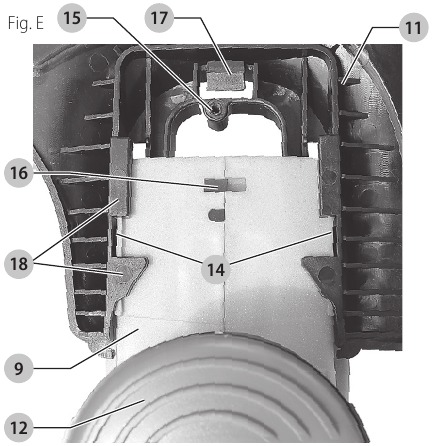
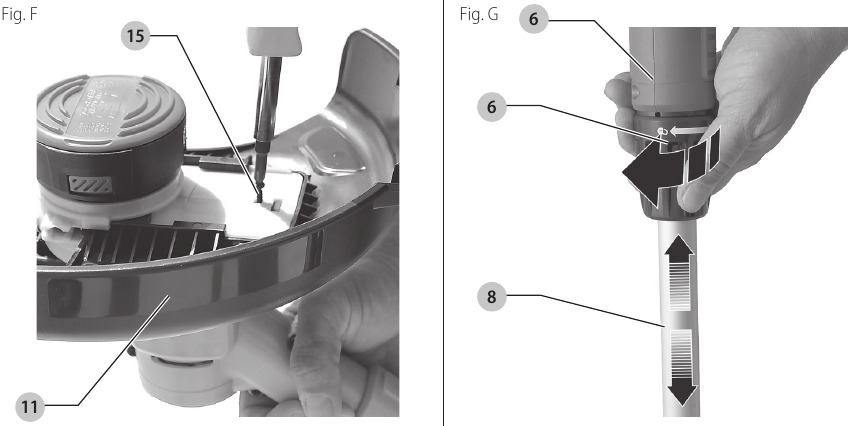
- To attach the auxiliary handle, press in on the auxiliary handle adjustment buttons on both sides of the upper housing.
- Position the auxiliary handle as shown in Fig. E – G. Partially push the auxiliary handle on so it will hold the buttons in when you release them with your hand.
- Push the auxiliary handle completely onto the housing and position it slightly until it "snaps" into place.
NOTE: To adjust the auxiliary handle up or down, press in on the buttons and raise or lower the handle.
NOTE: The handle should be adjusted so that your front arm is straight when the tool is in the working position.
Installing the Guard
(Fig. E, F)
NEVER OPERATE the appliance without the guard properly installed. Damage or personal injury could result. The guard must always be properly installed on the appliance during use.
- Remove the guard screw
![]() .
. - Slide the guard
![]() fully onto the motor housing
fully onto the motor housing ![]() .
.
Make sure the tabs![]() on the guard engage the ribs
on the guard engage the ribs ![]() on the trimmer head.
on the trimmer head. - Continue to slide the guard on until it "snaps" into place. The locking tab
![]() should snap into the housing slot
should snap into the housing slot ![]() .
. - Using a crosshead screwdriver, insert the guard screw
![]() and tighten securely.
and tighten securely. - Once the guard is installed, remove the covering from the line cut‑off blade, located on the edge of the guard.
Height Adjustment
(Fig. A, G)
Adjust the length of the trimmer to obtain proper working positions.
- The overall height of the trimmer can be adjusted by loosening the height‑adjust collar
![]() by rotating it in the direction of the arrow shown in Fig. A, G.
by rotating it in the direction of the arrow shown in Fig. A, G. - Move the upper housing straight up or down. When the desired height is achieved, tighten the collar by rotating it opposite of the direction shown in Fig. A, G.
Attaching Extension Cord
An extension cord retainer  is built into the main handle that prevents the cord from coming unplugged.
is built into the main handle that prevents the cord from coming unplugged.
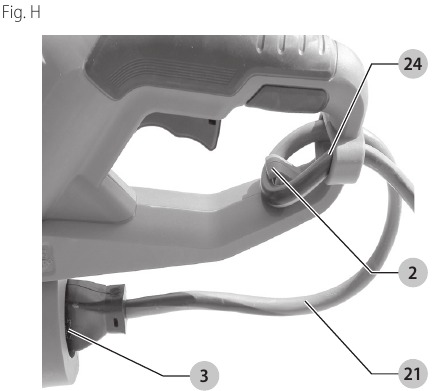
- To use this feature, simply double the extension cord about 8" (203 mm) from the end, and insert it into the slot
![]() in the end of the handle area as shown in Fig. H.
in the end of the handle area as shown in Fig. H. - Hook the loop formed by doubling the cord over the extension cord retainer
![]() . Gently tug on the cord to insure that it is firmly retained in the main handle.
. Gently tug on the cord to insure that it is firmly retained in the main handle. - Plug the receptacle end of the extension cord into the power cord plug
![]() in the main handle.
in the main handle.
Releasing the Cutting Line
(Fig. A)
As manufactured, the cutting line  is taped to the spool housing
is taped to the spool housing  .
.
- Remove the tape holding the cutting line
![]() to the spool housing
to the spool housing ![]() .
.
OPERATION
To reduce the risk of serious personal injury, turn unit off and disconnect it from power source before making any adjustments or removing/installing attachments or accessories, when replacing line, or prior to cleaning. An accidental start‑up can cause injury.
Always use proper eye protection that conforms to ANSI Z87.1 (CAN/CSA Z94.3) while operating this appliance.
Before you begin trimming, only use the appropriate type of cutting line. Refer to Replacing Spool Assembly and Rewinding Spool from Bulk Line sections.
Inspect area to be trimmed and remove any wire, cord, or string‑like objects which could become entangled in the rotating line or spool. Be particularly careful to avoid any wire which might be bent outwardly into the path of the appliance, such as barbs at the base of a chain link fence.
Proper Hand Position
To reduce the risk of serious personal injury, ALWAYS use proper hand position as shown.
To reduce the risk of serious personal injury, ALWAYS hold securely in anticipation of a sudden reaction.
Proper hand position requires one hand on the main handle  and one hand on the auxiliary handle
and one hand on the auxiliary handle  .
.
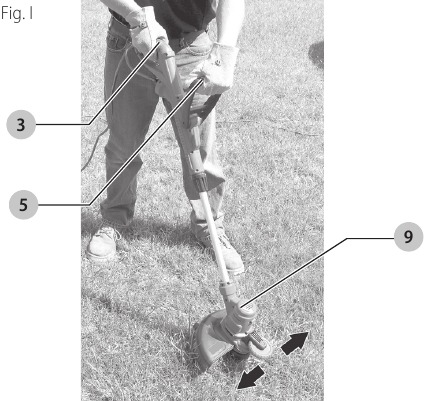
Switching Trimmer On and Off
(Fig. A)
Never attempt to lock the trigger in the on position.
- To turn the appliance on, squeeze the trigger
![]() .
. - To turn the appliance off, release the trigger.
Trimming
(Fig. I, J)
- With the trimmer on, angle it and swing side to side as shown in Fig. I.
- Maintain a cutting angle of 5° to 10°. Do not exceed 10°.
- Cut with the tip of the line.
- Maintain a minimum distance of 24" (610 mm) between the guard and your feet as shown in Fig. J.
![Black & Decker - GH900 - Trimming Trimming]()
- Use the edge guide wheel
![]() to limit line contact with objects such as fences, curbs, etc.
to limit line contact with objects such as fences, curbs, etc.
Convert to Edging Mode
(Fig. A, K)
Disconnect the plug from the power source before making any adjustments.
The trimmer can be used in trimming mode or edging mode to trim overhanging grass along lawn edges and flowerbeds.
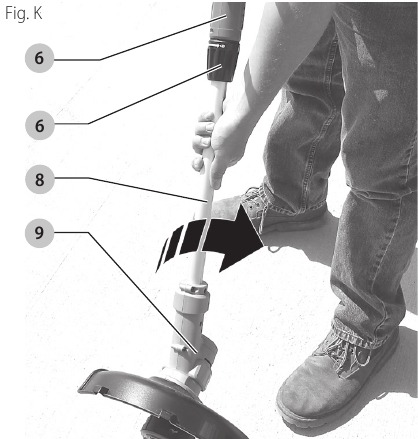
- To operate in edge mode, loosen the collar
![]() by twisting it counterclockwise.
by twisting it counterclockwise. - Rotate the motor housing
![]() 180° counterclockwise, until the motor housing snaps into edge position.
180° counterclockwise, until the motor housing snaps into edge position. - Twist the collar
![]() clockwise until tight to secure it into position.
clockwise until tight to secure it into position. - To return to the trimming position, loosen the lock collar and rotate the motor housing
![]() 180° clockwise back to its original position and tighten the collar
180° clockwise back to its original position and tighten the collar ![]() to secure it into position.
to secure it into position.
NOTE: You will experience faster than normal cutting line wear if the trimmer line is positioned directly over the sidewalk or abrasive surface.
Edging Mode Operation
(Fig. A, L)
When being used as an edger, stones, pieces of metal, pieces of line and other objects can be thrown out at high speed during use. The trimmer and guard are designed to reduce the hazard.
However, MAKE SURE that other persons and pets are at least 100' (30 m) away. Optimum cutting results are achieved on edges deeper than 2" (50 mm).
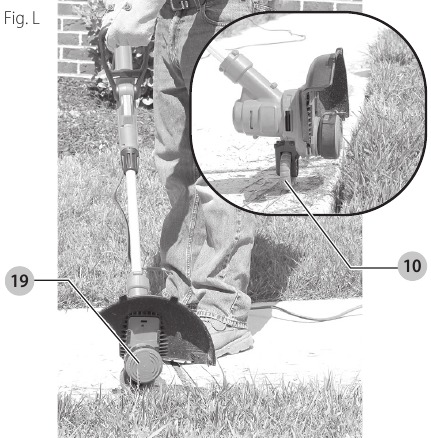
- Do not use this trimmer to create trenches.
- Using the edge guide
![]() , guide the trimmer.
, guide the trimmer. - Position the edging guide on the edge of the sidewalk or abrasive surface so the cutting line is over the grass or dirt area to be edged.
- To make a closer cut, slightly tilt the trimmer.
Helpful Cutting Tips
(Fig. A, I – L)
- Use the tip of the string to do the cutting; do not force string head into uncut grass. Use edge guide along such things as fences, houses and flower beds for best practices.
- Wire and picket fences cause extra string wear, even breakage. Stone and brick walls, curbs, and wood may wear string rapidly.
- Do not allow spool cap
![]() to drag on ground or other surfaces.
to drag on ground or other surfaces. - Do not strike the spool cap
![]() onto the ground to force the line to feed.
onto the ground to force the line to feed. - In long growth, cut from the top down and do not exceed 13" (330 mm) high.
- Keep trimmer tilted toward the area being cut; this is the best cutting area.
- The trimmer cuts when passing the unit from the left to right. This will avoid throwing debris at the operator.
- Avoid trees and shrubs. Tree bark, wood moldings, siding, and fence posts can easily be damaged by the string.
Cutting Line/Line Feeding
Your trimmer uses 0.065" (1.65 mm) diameter, round nylon line. As the line wears during use the automatic line feed system will advance new line from the spool housing. Each time it feeds line the end will be trimmed by the blade in the guard. You may hear a rattling sound and see small pieces of line exit from the guard when this occurs. Be sure to follow all instructions and wear appropriate safety glasses, closed toe shoes and long pants. When the trimmer is out of line the last few inches may exit the spool housing at once. Cutting line will wear faster and require more feeding if the cutting or edging is done along sidewalks or other abrasive surfaces or heavier weeds are being cut.
Clearing Jams and Tangled Line
Disconnect the plug from the power source before making any assembly, adjustments or changing accessories. Such preventive safety measures reduce the risk of starting the appliance accidentally.
From time to time, especially when cutting thick or stalky weeds, the line feeding hub may become clogged with sap or other material and the line will become jammed as a result. To clear the jam, follow the steps listed below.
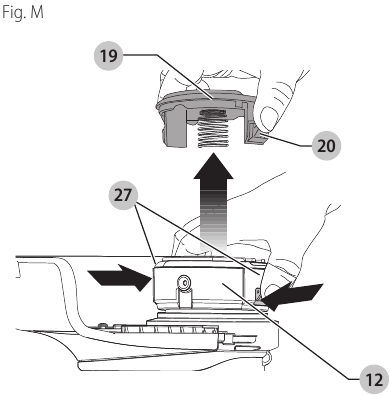
To avoid appliance damage, if the cutting line protrudes beyond the trimming blade, cut it off so that it just reaches the blade.
- Disconnect the plug from the power source
- Press the release tabs
![]() on the spool cap
on the spool cap ![]() , and remove the spool cap from the spool housing
, and remove the spool cap from the spool housing ![]() .
. - Pull the nylon line spool out and clear any broken line or cutting debris from the spool area.
- Fit the spool onto the appliance as described in Replacing Spool Assembly.
Replacing Spool Assembly
(Fig. M–P)
The use of any accessory not recommended by BLACK+DECKER for use with this appliance could be hazardous.
Do not use any blades, or any accessory or attachment other than those recommended by BLACK+DECKER on this trimmer/ edger. Serious injury or product damage may result.
Reload nylon line (either bulk or prewound replacement spool) as shown in this manual.
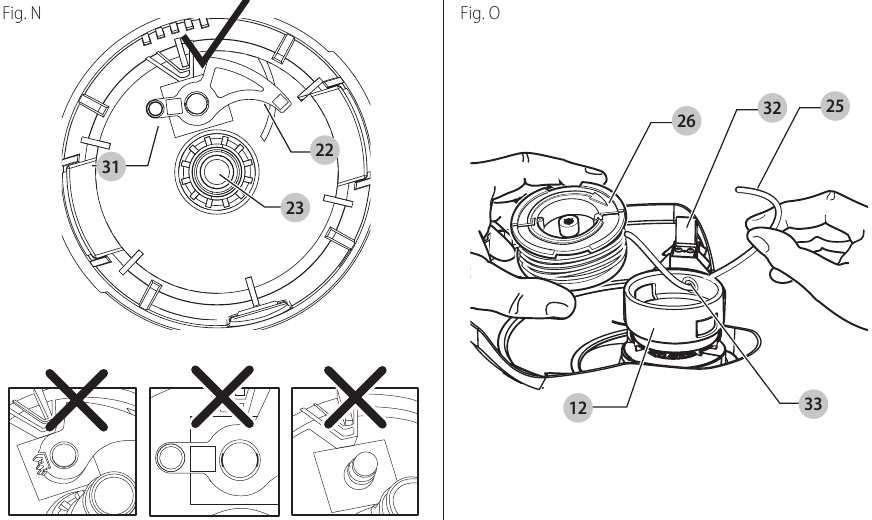
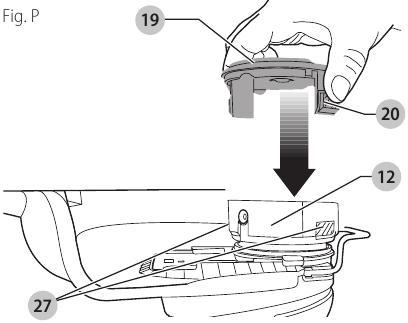
USE ONLY BLACK+DECKER REPLACEMENT SPOOL AF-100 or 0.065" (1.65 mm) DIAMETER ROUND NYLON MONOFILAMENT LINE. Do not use serrated or larger diameter line or line with a shape other than round, as they will affect the way the line feeds and overload the motor and cause overheating. This line is available at your local dealer or authorized service center. Do not use wire.
- Disconnect the plug from the power source.
- Remove battery from appliance.
- Press the release tabs
![]() on the spool cap
on the spool cap ![]() , and remove the spool cap from the spool housing
, and remove the spool cap from the spool housing ![]() .
. - Remove the empty spool
![]() from the spool housing
from the spool housing ![]() .
. - Inspect the lever
![]() to confirm that it is present and not broken or bent, and it pivots freely on the mounting post. Also confirm the metal ferrule
to confirm that it is present and not broken or bent, and it pivots freely on the mounting post. Also confirm the metal ferrule ![]() is present.
is present. - If the lever
![]() in the base of spool housing becomes dislodged, replace in the correct position before inserting the new spool into the housing.
in the base of spool housing becomes dislodged, replace in the correct position before inserting the new spool into the housing. - Remove any dirt and grass from the spool cap and spool housing.
- Unfasten the end of the cutting line
![]() and guide the line into the eyelet
and guide the line into the eyelet ![]() .
. - Take the fully wound spool
![]() and carefully slip it onto the post
and carefully slip it onto the post ![]() in the housing. Rotate the spool slightly, to align it with the lever
in the housing. Rotate the spool slightly, to align it with the lever ![]() , until it is seated.
, until it is seated. - The line should extend approximately 5‑3/8" (136 mm) from the housing.
- Inspect the spool cap
![]() for cracks or excessive wear. If any of the outer ribs are worn down to the main surface or there are cracks present, replace the spool cap
for cracks or excessive wear. If any of the outer ribs are worn down to the main surface or there are cracks present, replace the spool cap ![]() .
. - Align the release tabs on the spool cap with the slots
![]() in the spool housing.
in the spool housing. - Snap the spool cap
![]() back on by depressing release tabs
back on by depressing release tabs ![]() and pressing it into the spool housing
and pressing it into the spool housing ![]() until it snaps securely into place.
until it snaps securely into place. - Extend the cutting line
![]() from the spool housing
from the spool housing ![]() and cut so that it does extend past the cutting blade
and cut so that it does extend past the cutting blade ![]() .
.
NOTE: Make sure that cover is fully positioned. Listen for two audible clicks to ensure both release tabs are correctly located. Following prior instructions, power the appliance on. In a few seconds or less you'll hear the nylon line being cut automatically to the proper length.
NOTE: Other replacement parts (guards, spool caps, etc.) are available through authorized service centers. To find your local service location call: 1-800-544-6986 or visit www.blackanddecker.com.
Rewinding Spool from Bulk Line
Use Only 0.065" (1.65 mm) Diameter, Round Line
DO NOT use larger diameter line or line with a shape other than round.
NOTE: Hand wound spools from bulk line are likely to become tangled more frequently than BLACK+DECKER factory wound spools. For best results, factory wound spools are recommended.
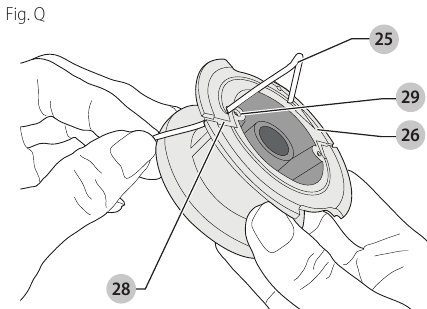
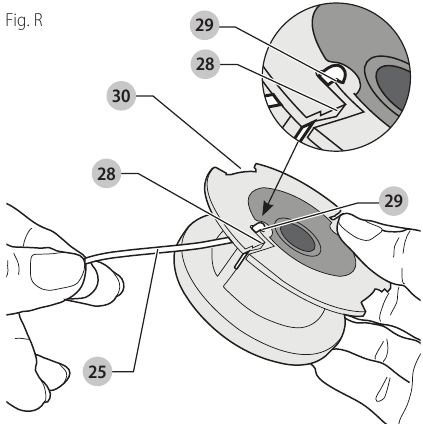
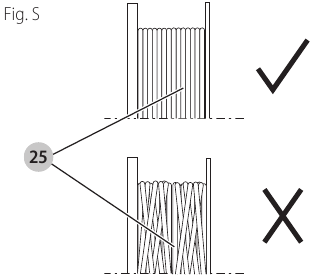
- Disconnect the plug from the power source.
- Remove the empty spool from the appliance and inspect as described in Replacing Spool Assembly.
- Remove any remaining cutting line from the spool.
- Make a fold at the end of the cutting line
![]() at about 3/4" (19 mm). Feed the cutting line into one of the line anchoring slots
at about 3/4" (19 mm). Feed the cutting line into one of the line anchoring slots ![]() .
. - Insert the 3/4" (19 mm) end of the bulk line into the hole
![]() in the spool adjacent to the slot. Make sure the line is pulled tight against the spool.
in the spool adjacent to the slot. Make sure the line is pulled tight against the spool. - Wind the cutting line onto the spool in the direction of the arrow on the spool. Make sure to wind the line on neatly and in layers. Do not crisscross.
- When the wound cutting line reaches the recesses
![]() , cut the line. DO NOT fill the spool beyond this point.
, cut the line. DO NOT fill the spool beyond this point. - Fit the spool onto the appliance as described in Replacing Spool Assembly.
MAINTENANCE
To reduce the risk of serious personal injury, turn unit off and disconnect it from power source before making any adjustments or removing/installing attachments or accessories, when replacing line, or prior to cleaning. An accidental start‑up can cause injury.
Your BLACK+DECKER power tool has been designed to operate over a long period of time with a minimum of maintenance. Continuous satisfactory operation depends upon proper tool care and regular cleaning.
Cleaning
Blow dirt and dust out of all air vents with clean, dry air at least once a week. To minimize the risk of eye injury, always wear ANSI Z87.1 approved eye protection when performing this procedure.
Never use solvents or other harsh chemicals for cleaning the non‑metallic parts of the tool. These chemicals may weaken the plastic materials used in these parts. Use a cloth dampened only with water and mild soap. Never let any liquid get inside the tool; never immerse any part of the tool into a liquid.
Accessories
Since accessories, other than those offered by BLACK+DECKER, have not been tested with this product, use of such accessories with this product could be hazardous. To reduce the risk of injury, only BLACK+DECKER recommended accessories should be used with this product.
Recommended accessories for use with your product are available at extra cost from your local dealer or authorized service center. If you need assistance in locating any accessory, please contact BLACK+DECKER. Call 1-800-544-6986.
Replacing Guard
(Fig. F, G)
Never operate appliance without guard firmly in place. Damage or personal injury could result.
Remove Current Guard
- Remove the guard screw
![]() shown in Fig. F.
shown in Fig. F. - Slide the guard
![]() off.
off.
Assembling the New Guard
- Slide the guard into place as shown in Fig. G.
- Replace and securely tighten the guard screw
![]() .
.
Repairs
To assure product SAFETY and RELIABILITY, repairs, maintenance and adjustment (including brush inspection and replacement, when applicable) should be performed by a factory service center or an authorized service center. Always use identical replacement parts.
Register Online
Thank you for your purchase. Register your product now for:
- WARRANTY SERVICE: Registering your product will help you obtain more efficient warranty service in case there is a problem with your product.
- CONFIRMATION OF OWNERSHIP: In case of an insurance loss, such as fire, flood or theft, your registration of ownership will serve as your proof of purchase.
- FOR YOUR SAFETY: Registering your product will allow us to contact you in the unlikely event a safety notification is required under the Federal Consumer Safety Act.
Register online at www.blackanddecker.com/account/login.
Documents / Resources
References
Download manual
Here you can download full pdf version of manual, it may contain additional safety instructions, warranty information, FCC rules, etc.
Advertisement




 .
. fully onto the motor housing
fully onto the motor housing 


 should snap into the housing slot
should snap into the housing slot  .
.
 in the end of the handle area as shown in Fig. H.
in the end of the handle area as shown in Fig. H.
 .
.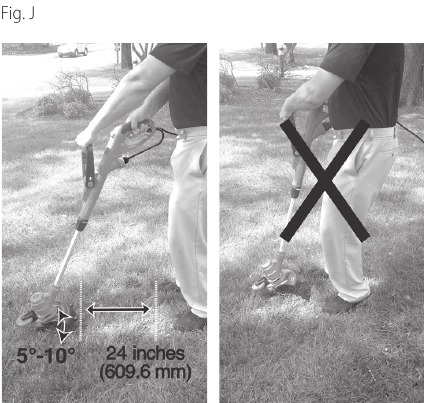
 to limit line contact with
to limit line contact with 

 to drag on ground or other surfaces.
to drag on ground or other surfaces. on the spool cap
on the spool cap  .
.


 is present.
is present.
 .
. in the housing. Rotate the spool slightly, to align it with the lever
in the housing. Rotate the spool slightly, to align it with the lever  in the spool housing.
in the spool housing. .
. at about 3/4" (19 mm). Feed the cutting line into one of the line anchoring slots
at about 3/4" (19 mm). Feed the cutting line into one of the line anchoring slots  .
. in the spool adjacent to the slot. Make sure the line is pulled tight against the spool.
in the spool adjacent to the slot. Make sure the line is pulled tight against the spool. , cut the line. DO NOT fill the spool beyond this point.
, cut the line. DO NOT fill the spool beyond this point. shown in Fig. F.
shown in Fig. F. off.
off.

















Need help?
Do you have a question about the GH900 and is the answer not in the manual?
Questions and answers